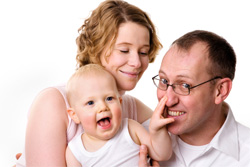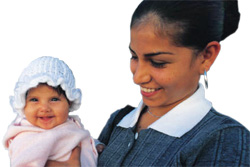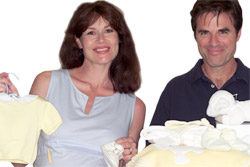- What is ovulation?
- What are ovarian stimulation and hyperstimulation?
- History of ovarian stimulation
- Who can use ovarian stimulation or hyperstimulation?
- How does ovarian stimulation work?
- How does ovarian stimulation work?
- What to expect and how to prepare
- Benefits of using ovarian stimulation
- Limitations and risks of using ovarian stimulation
What is ovulation?

There are two stages of the ovulatory cycle, the follicular and the luteal phase, which are interrupted by events known as ovulation (i.e. the release of a mature oocyte into the fallopian tubes) and menstruation (i.e. the expulsion, via the vagina, of the endometrial lining or uterus wall, developed in the previous ovulatory cycle). The follicular phase commences on the first day of menstrual bleeding. The luteal phase commences immediately following ovulation.
The follicular stage of menstruation is characterised by increasing levels of the hormone oestrogen, the growth of ovarian follicles (i.e. the follicles in the ovaries which contain immature oocytes) and the thickening of the endometrial wall (i.e. the wall of the uterus). In the very early follicular stage it is common for numerous ovarian follicles to develop, however after a couple of days, when levels of a human hormone or gonadotrophin called Follicle Stimulating Hormone (FSH) drop sharply, the majority of developing follicles die. Typically a single follicle will continue to develop, however in rare cases hormone levels will support the growth of more than one follicle. Each ovarian follicle contains a single oocyte which will mature as the ovarian follicle develops. When the oocyte has fully matured, the follicle ruptures and releases the oocyte.
The process through which an ovarian follicle ruptures and releases its mature oocyte is called ovulation. It generally occurs half way through an ovulatory cycle (i.e. on day 14 of a 28 day menstrual cycle). The oocyte is expelled from the ovaries following maturation and follicle rupture. It enters the fallopian tubes where, if it comes into contact with sperm, it can be fertilised, implant in the woman’s uterus and form a pregnancy. The remains of the ruptured ovarian follicle stay in the ovaries, where it transforms into a structure known as the corpus luteum. The corpus luteum is a temporary structure, the main purpose of which is to produce the hormones progesterone and oesterogen, in order to prepare the uterus for possible pregnancy.
Following ovulation, the luteal phase of the ovulatory cycle commences. This begins with follicle rupture, oocyte release and the transformation of the ovarian follicle into the corpus luteum. The luteal phase is characterised by increasing progesterone and decreasing oestrogen production, as well as further thickening of the endometrial wall, in preparation for embryo implantation. If the egg released during ovulation is fertilised, the embryo (i.e. the fertilised egg) will immediately commence production of a pregnancy related hormone called human chorionic gonadotrophin (hCG). The production of hCG signals the corpus luteum to continue producing progesterone in order to support the forming pregnancy. However, if fertilisation does not occur, the corpus luteum will cease progesterone production and die. The endometrial lining, without a supply of progesterone from the corpus luteum, will break away from the uterus, resulting in menstrual bleeding, which also signals the commencement of the next ovulatory cycle.
What are ovarian stimulation and hyperstimulation?

However stimulation is most commonly used to induce ovarian hyperstimulation. Ovarian hyperstimulation is a menstrual cycle in which several ovarian follicles develop simultaneously and release multiple mature oocytes.
Ovarian stimulation is a standard procedure in assisted reproduction and is used in conjunction with in vitro fertilisation (IVF), intrauterine insemination (IUI) and other assisted reproductive techniques (ART). In addition to preparing oocytes for retrieval, ovarian stimulation also prepares a woman’s uterus for embryo implantation, by supporting the growth of the endometrial lining, the tissues into which the embryo will implant if an egg is fertilised.
The process of ovarian stimulation for ART involves at least two, and usually three stages:
- Medications (gonadotrophins or anti-oestrogens) are administered to stimulate the growth of ovarian follicles which then begin the preliminary maturation of oocytes;
- Medications to prevent surges in lutenising hormone (LH) (ithe gonadotrophin which regulates oocyte release from follicles) are administered to ensure that oocytes remain within their follicles, rather than being released into the fallopian tubes;
- Human chorionic gonadotrophin (hCG) is administered to stimulate the final maturation of oocytes, a process which takes just over 36 hours, following which the ovarian follicles rupture and release oocytes. Thus, associated ART procedures, for example IUI or oocyte pickup, are timed to occur 36 hours following administration of hCG, the third and final stage of the ovarian stimulation protocol.
History of ovarian stimulation
Ovarian stimulation is a cornerstone of ART technology as it enables:
- Ovulation to be induced in anovulatory women;
- Induction of hyper-ovulation (i.e. a menstrual cycle in which numerous follicles mature simultaneously);
- Prediction of the timing of oocyte maturation; which in turn enables
- Scheduling of oocyte retrieval and IUI and/or the collection of numerous mature oocytes per cycle.
Ovarian stimulation is also used to induce thickening of the endometrial wall in preparation for embryo implantation, in women undergoing IVF ‘thaw’ cycles (i.e. women having thawed IVF embryos implanted, who therefore do not need to undergo oocyte collection), those having donor IVF embryos implanted and those acting as gestational surrogates. Pharmacological stimulation is now standard practice in all ART cycles and over the years numerous medication regimes have been developed.
However in the early days of IVF the role of ovarian stimulation was poorly understood and hotly debated. Ovarian stimulation was generally abandoned by IVF scientists in the late 1970s following the birth of the first IVF baby from a natural cycle. Pharmacological ovarian stimulation was re-introduced in Australian IVF laboratories in 1981. The use of pharmacological hyperstimulation greatly increased the efficiency of ART treatments, by enabling numerous oocytes to be collected per cycle. Inducing oocyte maturation enabled doctors to accurately predict the time at which eggs would mature and should be collected, which increased fertilisation rates.
Who can use ovarian stimulation or hyperstimulation?

However when IUI is performed to overcome male factors (e.g. because the man’s sperm is immotile) ovarian stimulation is not required, as it does not result in higher pregnancy rates than when IUI is performed in a natural menstrual cycle.
Ovarian hyperstimulation is typically used in all patients undergoing IVF treatment or wishing to retrieve and store oocytes for future use.
How does ovarian stimulation work?
Ovulation stimulation medication regimes work by regulating various endocrine functions (i.e. functions related to reproductive hormones). To a large extent these medication regimes simply stimulate normal ovarian functions (e.g. follicle development, growth of the endometrial lining). However, unlike in a natural cycle when the timing of hormonal changes is dictated by naturally occurring hormonal changes, in a stimulated cycle, each hormonal change is scheduled to occur at a time which will optimise the quality of oocytes released. The administration of medications will be timed to enable the administration of associated ART processes (e.g. IUI, oocyte retrieval).
Stimulation of follicular growth
The first phase of a stimulation cycle coincides with the follicular phase of a normal menstrual cycle and is designed to induce the maturation of numerous ovarian follicles, simultaneously. As mentioned above, the majority of ovarian follicles typically die in the first few days of the cycle, as levels of the gonadotrophins follicle stimulating hormone (FSH) and lutenising hormone (LH) decrease. As such, to enable numerous ovarian follicles to continue growing, it is necessary to artificially increase gonadotrophin concentrations. The first phase of a stimulated cycle therefore involves the administration of gonadotrophin-containing compounds or compounds which can stimulate natural gonadotrophin production. The aim is to overcome the decline in FSH and LH levels (and subsequently the death of all but the dominant ovarian follicle), a decline which generally occurs on day 5-7 of the menstrual cycle.
The medications most commonly used to stimulate ovarian follicular growth are discussed further below.
Clomifene Citrate a non-steroidal oestrogen antagonist, developed in the 1950s. Non-steroidal oestrogen antagonists were initially used to treat breast cancer and it was in this application that the ability of such compounds to induce ovulation was observed. Clomifene citrate works by blocking serum estrodiol feedback, which induces increased FSH secretion. It remains the first line treatment for anovulatory infertility today and the most commonly used pharmaceutical in ART therapy. In addition to treating anovulatory infertility, Clomiphene citrate is used to treat infertility related to endometriosis. It is used in conjunction with normal sexual intercourse, IUI and IVF. Clomifene is administered between days 1-5 of the menstrual cycle, in doses of 100-150mg, for five days. The drug regimen is cheap and medications are taken orally.
Gonadotrophins there are a range of gonadotrophin containing compounds used in ovarian stimulation and they are the principle ovarian stimulation agents used in IVF. Gonadotrophin administration (starting dose from 100-300 IU/day) typically leads to the growth of numerous ovarian follicles and collection of numerous mature oocytes. Gonadotrophin administration may commence either in the late luteal phase of the previous menstrual cycle or in the early follicular phase. The appropriate dose will vary from woman to woman. The most commonly used gonadotrophin containing compounds are Human Menopausal Gonadotrophin (HMG), purified urinary Follicle Stimulating Hormone (uFSH) and recombinant Follicle Stimulating Hormone (rFSH).
Preventing premature surges in LH
Following the follicular stimulation phase of an ovarian stimulation protocol, the ovaries will be assessed by ultrasound. A clinician will be able to determine from the ultrasound whether or not the ovarian follicles have grown sufficiently (to a size of 16-18mm in diameter) and the endometrial wall has thickened sufficiently, to indicate oocyte maturation.
A second combination of medications will then be administered at some point after an ultrasound. The ultrasonic images of the ovaries will enable a doctor to determine the optimum time for medications to be commenced. The aim of the second phase is to prevent the premature release of oocytes from their follicles. Premature release occurs as a result of surges in the level of LH, and so, this stage of the medication regime aims to regulate the production of LH to prevent surges which will trigger oocyte release.
The medications most commonly used for this purpose are Gonadotrophin releasing hormone (GnRH) analogues. GnRH is a hormone which stimulates the synthesis and secretion of FSH and LH. GnRH analogues interrupt GnRH production and thus also FSH and LH secretion. There are two types:
GnRH agonists have been used to prevent LH surges since the 1980s and can be administered as a short or long regime. As part of a “long regime”, they are ideally commenced in the mid luteal phase of the previous menstrual cycle and continued until hCG is administered to induce final oocyte maturation. This regime begins with a short stimulatory phase (commonly referred to as a “flare”), before gonadotrophin levels are reduced prior to gonadotrophin stimulation. However this approach is time-consuming and a short protocol (also known as a flare or flare up cycle) can be used. In this cycle GnRH agonists are commenced on day 2 of the menstrual cycle, one day before the commencement of gonadotrophins.
GnRH antagonists were recognised in the early days of ART as a potentially useful “short regime” medication, due to their ability to immediately reduce GnRH secretion. However, clinically safe preparations were not approved until 2001 and results to date show lower pregnancy rates using GnRH antagonists than agonists.
Inducing final oocyte maturation
When a woman’s ovaries are assessed via ultrasound following the first stage of ovarian stimulation (i.e. following follicular stimulation), the information will also be used by the clinician to determine the correct day to induce the final stage of oocyte maturation (the stage in which mature oocytes are prepared for release from their follicles). This phase is induced through administration of a hCG injection, which is given 36 hours prior to the time at which oocyte pick up or IUI are scheduled.
Other medications used in ovarian stimulation regimes
There are a number of other medications which play an important role in ovarian stimulation regimes. For some women, a treatment cycle will begin with a “down regulation” phase – a phase in which hormone levels are artificially reduced so that they do not interfere with the synthetic hormones which will be administered in the follicular development phase. Oral contraceptive pills are commonly prescribed for the down regulation phase, however GnRH agonists can also be used. Patients with Polycystic Ovarian Syndrome (PCOS) are often prescribed Metformin, to reduce insulin levels.
What to expect and how to prepare

The treatment process will be explained to the couple during these consultations, and detailed instructions will be given regarding how and when the medications involved should be administered.
Most stimulation cycles involve medications which must be injected and couples will also receive training so that they are able to administer injections at home and prevent the need for numerous trips to a clinic. Medications will be prescribed for the couple to take home prior to the start of their treatment cycle (i.e. the first day of the menstrual cycle, indicated by the commencement of menstrual bleeding), so that they are ready to begin treatment at the appropriate time.
All women intending to commence a treatment cycle involving ovarian stimulation will be asked to contact their IVF clinic on the first day of their menstrual cycle (i.e. the day menstrual bleeding starts). When they do this a clinician will inform them when they should commence taking the medication prescribed for their treatment, and when they should re-attend the ART clinic for ultrasonic assessment of ovarian follicles. Following ultrasound, the woman being treated will be advised when she should administer hCG to stimulate oocyte maturation. An appointment for oocyte retrieval or IUI will be scheduled for 36 hours after hCG administration.
The medications consumed to stimulate ovarian functions produce mild side effects (including mood swings and abdominal pain) in a significant proportion of women. In addition many couples find the process of waiting to see if ovarian stimulation is successful quite stressful and may wish to attend counselling throughout the treatment cycle. This may be particularly the case if the couple has experience previous cancelled cycles.
Benefits of using ovarian stimulation
Ovarian stimulation vastly increases the efficiency of ART by enabling the collection of numerous mature oocytes per cycle. It can also be used to induce ovulation in anovulatory women, and thus benefits many infertile couples by enabling them to conceive.
Limitations and risks of using ovarian stimulation
Ovarian stimulation is not a replacement for viable oocytes, and stimulating ovulation in women whose oocytes are suboptimal will result in suboptimal fertilisation and implantation rates, even if numerous oocytes are retrieved.
In addition there are a number of discomforts and health risks associate with ovarian stimulation. All women experience enlarged ovaries as a result of ovarian stimulation and some 4% experience abdominal bloating and discomfort in the pelvis. While many professionals have expressed concern that stimulating hyper-ovulation may increase the risk of ovarian cancers, there is currently no evidence to support this hypothesis.
In around 1% of women undergoing stimulation, a potentially life threatening condition, ovarian hyperstimulation syndrome (OHSS) occurs. It is characterised by severe abdominal pains and fluid retention and usually begins several days after embryo transfer. While OHSS often resolves naturally, it is a potentially life threatening condition which sometimes requires hospitalisation. In 2003, around 1% (390 women) of women undergoing IVF were hospitalised due to complications associated with ART treatments. Ovarian hyperstimulation syndrome was the most common cause of IVF related hospitalisation, representing 56% (218) of all hospitalisations for IVF related complications in 2003.
More information
 |
For more information on infertility, including investigations and treatments, as well as some useful animations, see Infertility. |
 |
For more information on alternative treatments, see Infertility Treatments / Assisted Reproductive Technologies (ARTs). |
References
- Macklon NS, Stouffer RL, Giudice LC, Fauser BC. The science behind 25 years of ovarian stimulation for in vitro fertilization. Endocr Rev. 2006;27(2):170-207.
- Cohen J, Trounson A, Dawson K, Jones H, Hazekamp J, Nygren KG, et al. The early days of IVF outside the UK. Hum Reprod Update. 2005;11(5):439-59.
- Arslan M, Bocca S, Mirkin S, Barroso G, Stadtmauer L, Oehninger S. Controlled ovarian hyperstimulation protocols for in vitro fertilization: two decades of experience after the birth of Elizabeth Carr. Fertil Steril. 2005;84(3):555-69.
- Cohen J. A short review of ovarian stimulation in assisted reproductive techniques. Reprod Biomed Online. 2003;6(3):361-6.
- Balen AH, Rutherford AJ. Management of infertility. BMJ. 2007;335(7620):608-11.
- National Collaborating Centre for Women’s and Children’s Health. Clinical guideline: Fertility: Assessment and treatment for people with fertility problems [online]. Royal College of Obstetricians and Gynaecologists. 1 February 2004 [cited 30 December 2008]. Available from: [URL Link]
- Daya S. Gonadotropin releasing hormone agonist protocols for pituitary desensitization in in vitro fertilization and gamete intrafallopian transfer cycles. Cochrane Database Syst Rev. 2000;(2):CD001299.
- Al-Inany H, Aboulghar M. GnRH antagonist in assisted reproduction: A Cochrane review. Hum Reprod. 2002;17(4):874-85.
- Loutradis D, Drakakis P, Vomvolaki E, Antsaklis A. Different ovarian stimulation protocols for women with diminished ovarian reserve. J Assist Reprod Genet. 2007;24(12):597-611.
- Cantineau AE, Cohlen BJ, Heineman MJ. Ovarian stimulation protocols (anti-oestrogens, gonadotrophins with and without GnRH agonists/antagonists) for intrauterine insemination (IUI) in women with subfertility. Cochrane Database Syst Rev. 2007;(2):CD005356.
- Monash IVF. A treatment cycle for women [online]. Sydney: Monash IVF Australia; 2008 [cited 31 March 2010]. Available from: [URL Link]
- Albany IVF. Patient information [online]. New York: Albany IVF; 2009 [cited 31 March 2010]. Available from: [URL Link]
- National Health and Medical Council of Australia. Ethical guidelines on the use of assisted reproductive technology in clinical practice and research [online]. Australian Government National Health and Medical Council. June 2007 [cited 30 December 2008]. Available from: [URL Link]
- Waters AM, Dean JH, Sullivan EA. Assisted reproduction technology in Australia and New Zealand 2003 [online]. Australian Institute for Health and Welfare, National Perinatal Statistics Unit. February 2006 [cited 10 December 2008]. Available from: [URL Link]
All content and media on the HealthEngine Blog is created and published online for informational purposes only. It is not intended to be a substitute for professional medical advice and should not be relied on as health or personal advice. Always seek the guidance of your doctor or other qualified health professional with any questions you may have regarding your health or a medical condition. Never disregard the advice of a medical professional, or delay in seeking it because of something you have read on this Website. If you think you may have a medical emergency, call your doctor, go to the nearest hospital emergency department, or call the emergency services immediately.







